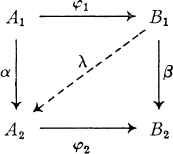Article contents
Obstructions to Liftings in Commutative Squares
Published online by Cambridge University Press: 20 November 2018
Extract
A commutative square (1) of morphisms is said to have a lifting if there is a morphism λ: B1 → A2 such that λϕ1 = α and ϕ2λ = β
1
Let us assume that we are working in a fixed abelian category  . Therefore, ϕi will have a kernel “Ki” and a cokernel “Ci” for i = 1, 2. Let k : K1 → K2 and c: C1 → C2 denote the canonical morphisms induced by α and β.
. Therefore, ϕi will have a kernel “Ki” and a cokernel “Ci” for i = 1, 2. Let k : K1 → K2 and c: C1 → C2 denote the canonical morphisms induced by α and β.
We shall construct a short exact sequence (s.e.s.)
2
using the data of (1). We shall prove that (1) has a lifting if and only if k = 0, c = 0, and (2) represents the zero class in Ext1(C1, K2). Furthermore, if (1) has one lifting, then the liftings will be in one-to-one correspondence with the elements of the set |Hom(G1, K2)|.
- Type
- Research Article
- Information
- Copyright
- Copyright © Canadian Mathematical Society 1971
References
- 2
- Cited by


